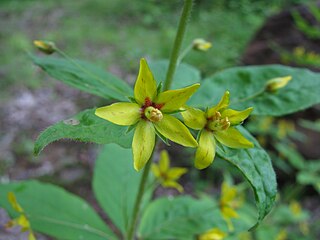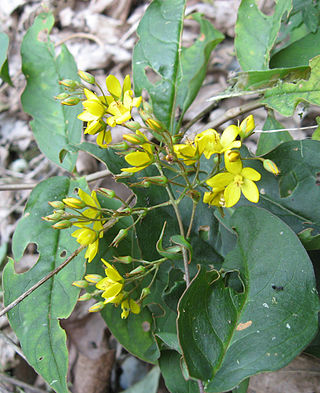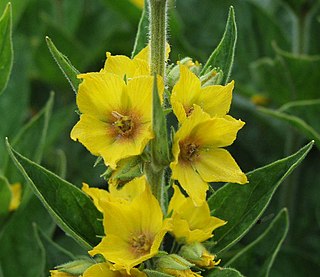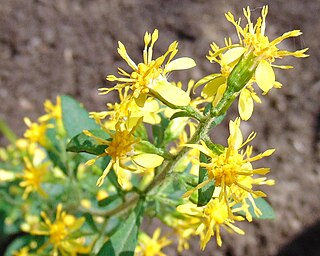
Lysimachia is a genus consisting of 193 accepted species of flowering plants traditionally classified in the family Primulaceae. Based on a molecular phylogenetic study it was transferred to the family Myrsinaceae, before this family was later merged into the Primulaceae.

Lysimachia nemorum, the yellow pimpernel, is a perennial flowering plant in the family Primulaceae.

Lysimachia europaea is a flowering plant in the primrose family Primulaceae, called by the common name chickweed-wintergreen or arctic starflower. It is a small herbaceous perennial plant with one or more whorls of leaves on a single slender erect stem. It is about one third of a foot high (10 cm), giving it its generic name.? The broad lanceolate leaves are pale green but take on a copper hue in late summer. The solitary white flowers are reminiscent of small wood anemones and appear in midsummer. The fruits are globular dry capsules but are seldom produced.

Lysimachia thyrsiflora, the tufted loosestrife, is a plant in the genus Lysimachia. It is native to large sections of the northern Northern Hemisphere, including Eurasia and North America. It often grows in marshes, shorelines of lakes and ponds and occasionally along streams. It is an erect perennial herb growing up to 80 centimeters tall and bearing yellow flowers, sometimes dotted with purple. It may be confused with purple loosestrife when not blooming but can be easily distinguished because purple loosestrife has a square stem. Tufted loosestrife has been used medicinally in Asia to combat high blood pressure.

Lysimachia vulgaris, the yellow loosestrife or garden loosestrife, is a species of herbaceous perennial flowering plant in the family Primulaceae. It was transferred to Myrsinoideae based on results of molecular phylogenetic research before being merged into the Primulaceae.

Lysimachia terrestris is a plant in the family Primulaceae.

Lysimachia quadrifolia, the whorled loosestrife, whorled yellow loosestrife, or crosswort, is a species of herbaceous plant in the family Primulaceae. It native to the eastern United States and Canada.

Lysimachia ciliata, the fringed loosestrife, is a species of flowering plant in the family Primulaceae. It is an erect herbaceous perennial growing to 120 cm (47 in) tall and 60 cm (24 in) broad, with opposite, simple leaves, and smooth green stems. The star-shaped yellow flowers are borne in midsummer. It is native to North America, including most of southern Canada and most of the United States except for the southwest. This plant is notable in that it is one of the few species of Lysimachia to bear elaiophores, that is, to offer oil instead of nectar as a reward to pollinators. It is pollinated in the northern part of its range by the specialist oil bee Macropis nuda, a native bee species whose survival depends upon this host plant.

Lysimachia fraseri is a rare species of flowering plant in the primrose family known by the common name Fraser's yellow loosestrife. It is native to the Southeastern United States, where it is listed as an endangered species in several states.

Lysimachia congestiflora, known as golden globes loosestrife or creeping Jenny, is a flowering plant species in the primrose family that native to southeast Asia.

Lysimachia punctata, the dotted loosestrife, large yellow loosestrife, circle flower, or spotted loosestrife, is a flowering plant species in the family Primulaceae.

Lysimachia asperulifolia is a rare species of flowering plant in the Primulaceae known by the common name rough-leaved loosestrife and roughleaf yellow loosestrife. It is endemic to the Atlantic coastal plain in North Carolina and northern South Carolina in the United States, where there are 64 known populations. It is a federally listed endangered species of the United States.

Lysimachia iniki is a rare species of flowering plant in the family Primulaceae known by the common names Wailua River yellow loosestrife and Wailua River island-loosestrife. It is endemic to Hawaii, where there is only one known occurrence existing on the island of Kauai. The plant was federally listed as an endangered species of the United States in 2010.
Lysimachia pendens is a rare species of flowering plant in the family Primulaceae known by the common name broad-leaf yellow loosestrife. It is endemic to Hawaii, where there is a single occurrence known on the island of Kauai. It was federally listed as an endangered species of the United States in 2010.
Lysimachia venosa is a rare species of flowering plant in the family Primulaceae known by the common name veined yellow loosestrife. It is endemic to Hawaii, where it is known only from the island of Kauai. The plant was only collected twice, last in 1911, but in 1991, a branch was discovered that had broken off the steep cliffs above the headwaters of the Wailua River. The branch was from a plant of this species and may have fallen from the summit of Mount Waialeale. No more specimens have been found since and the plant may be extinct, but some experts believe it may still exist in unsurveyed parts of the habitat. It was federally listed as an endangered species of the United States in 2010.

Lysimachia clethroides, the gooseneck loosestrife, is a species of flowering plant, traditionally classified in the family Primulaceae. It was transferred to the family Myrsinaceae based on a molecular phylogenetic study, but this family was later merged into the Primulaceae.

Lysimachia quadriflora, the fourflower yellow loosestrife, is a species of herbaceous plant in the family Primulaceae. It native to the eastern United States and Canada.

Solidago macrophylla, the largeleaf goldenrod or large-leaved goldenrod, is North American species of herbaceous perennial plants of the family Asteraceae. It is native to eastern and central Canada and the north-eastern United States. Some of the populations in Québec and Labrador lie north of the Arctic Circle.
Lysimachia × commixta is a hybrid of flowering plants in the primrose family Primulaceae. It is native to eastern North America, from eastern Canada across the Great Lakes region west to Minnesota. The hybrid specific epithet commixta means "mixed together, mixed up", which presumably refers to the genetic mixing of two species. Indeed, the hybrid is sometimes referred to as the mixed loosestrife or the commingling loosestrife.
Lysimachia × producta is a hybrid of flowering plants in the primrose family Primulaceae. It is native to eastern North America, from Quebec south to North Carolina, as far west as Wisconsin. The hybrid specific epithet producta means "stretched out, extended", a reference to the shape of its inflorescence. Indeed, the hybrid is sometimes referred to as the elongated loosestrife.














